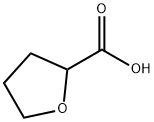Benzofuran-2-carboxylic acid
Synonym(s):Coumarilic acid;Coumarone-2-carboxylic acid
- CAS NO.:496-41-3
- Empirical Formula: C9H6O3
- Molecular Weight: 162.14
- MDL number: MFCD00005848
- EINECS: 207-818-9
- SAFETY DATA SHEET (SDS)
- Update Date: 2024-12-18 14:15:30

What is Benzofuran-2-carboxylic acid?
Chemical properties
white to light yellow crystal powde
The Uses of Benzofuran-2-carboxylic acid
Benzofuran-2-carboxylic acid was used in the synthesis of the oxymethyl-modified coumarinic acid-based cyclic DADLE (H-Tyr-D-Ala-Gly-Phe-D-Leu-OH) prodrug.
What are the applications of Application
Benzofuran-2-carboxylic acid is a synthesis reagent
Synthesis Reference(s)
Journal of the American Chemical Society, 73, p. 872, 1951 DOI: 10.1021/ja01146a532
Organic Syntheses, Coll. Vol. 3, p. 209, 1955
Purification Methods
The acid crystallises from water. [Beilstein 18/6 V 419.]
Properties of Benzofuran-2-carboxylic acid
| Melting point: | 193-196 °C (lit.) |
| Boiling point: | 310-315°C |
| Density | 1.2599 (rough estimate) |
| refractive index | 1.5380 (estimate) |
| Flash point: | 310-315°C |
| storage temp. | Keep in dark place,Sealed in dry,Room Temperature |
| solubility | soluble in Methanol,Ethanol,Acetone |
| pka | 3.12±0.30(Predicted) |
| form | Crystals or Powder |
| color | White to yellow |
| Water Solubility | partially soluble |
| Merck | 14,2561 |
| BRN | 124204 |
| CAS DataBase Reference | 496-41-3(CAS DataBase Reference) |
| NIST Chemistry Reference | Benzofuran-2-carboxylic acid(496-41-3) |
| EPA Substance Registry System | 2-Benzofurancarboxylic acid (496-41-3) |
Safety information for Benzofuran-2-carboxylic acid
| Signal word | Warning |
| Pictogram(s) |
 Exclamation Mark Irritant GHS07 |
| GHS Hazard Statements |
H315:Skin corrosion/irritation H319:Serious eye damage/eye irritation H335:Specific target organ toxicity, single exposure;Respiratory tract irritation |
| Precautionary Statement Codes |
P261:Avoid breathing dust/fume/gas/mist/vapours/spray. P264:Wash hands thoroughly after handling. P264:Wash skin thouroughly after handling. P271:Use only outdoors or in a well-ventilated area. P280:Wear protective gloves/protective clothing/eye protection/face protection. P302+P352:IF ON SKIN: wash with plenty of soap and water. P305+P351+P338:IF IN EYES: Rinse cautiously with water for several minutes. Remove contact lenses, if present and easy to do. Continuerinsing. |
Computed Descriptors for Benzofuran-2-carboxylic acid
New Products
(S)-3-Aminobutanenitrile hydrochloride 4-Methylphenylacetic acid N-Boc-D-alaninol N-BOC-D/L-ALANINOL Tert-butyl bis(2-chloroethyl)carbamate 3-Morpholino-1-(4-nitrophenyl)-5,6-dihydropyridin- 2(1H)-one Furan-2,5-Dicarboxylic Acid Tropic acid 1-Bromo-3,5-Di-Tert-Butylbenzene S-2-CHLORO PROPIONIC ACID ETHYL ISOCYANOACETATE 2-Bromo-1,3-Bis(Dimethylamino)Trimethinium Hexafluorophosphate 4-IODO BENZOIC ACID 3-NITRO-2-METHYL ANILINE 1-(2,4-DICHLOROPHENYL) ETHANAMINE (2-Hydroxyphenyl)acetonitrile 4-Bromopyrazole 2-(Cyanocyclohexyl)acetic acid 4-methoxy-3,5-dinitropyridine 1-(4-(aminomethyl)benzyl)urea hydrochloride 2-aminopropyl benzoate hydrochloride diethyl 2-(2-((tertbutoxycarbonyl)amino) ethyl)malonate tert-butyl 4- (ureidomethyl)benzylcarbamate Ethyl-2-chloro((4-methoxyphenyl)hydrazono)acetateRelated products of tetrahydrofuran




![Benzo[b]thien-2-ylboronic acid](https://img.chemicalbook.in/CAS/GIF/98437-23-1.gif)



You may like
-
 Benzofuran-2-carboxylic Acid CAS 496-41-3View Details
Benzofuran-2-carboxylic Acid CAS 496-41-3View Details
496-41-3 -
 Benzofuran-2-carboxylic acid CAS 496-41-3View Details
Benzofuran-2-carboxylic acid CAS 496-41-3View Details
496-41-3 -
 Benzofuran-2-carboxylic acid, 99% CAS 496-41-3View Details
Benzofuran-2-carboxylic acid, 99% CAS 496-41-3View Details
496-41-3 -
 Benzofuran-2-carboxylic acid 95% CAS 496-41-3View Details
Benzofuran-2-carboxylic acid 95% CAS 496-41-3View Details
496-41-3 -
 Benzofuran-2-carboxylic acid CAS 496-41-3View Details
Benzofuran-2-carboxylic acid CAS 496-41-3View Details
496-41-3 -
 496-41-3 Benzofuran-2-carboxylic acid, 97% 99%View Details
496-41-3 Benzofuran-2-carboxylic acid, 97% 99%View Details
496-41-3 -
 14714-50-2 (2-Hydroxyphenyl)acetonitrile 98+View Details
14714-50-2 (2-Hydroxyphenyl)acetonitrile 98+View Details
14714-50-2 -
 118753-70-1 98+View Details
118753-70-1 98+View Details
118753-70-1
Statement: All products displayed on this website are only used for non medical purposes such as industrial applications or scientific research, and cannot be used for clinical diagnosis or treatment of humans or animals. They are not medicinal or edible.